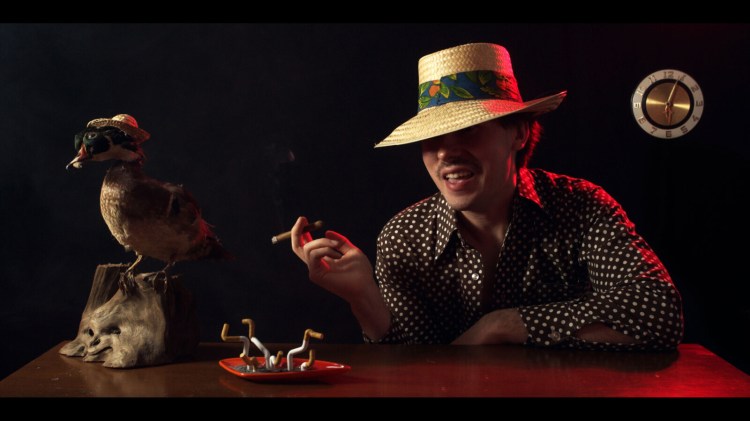Advances in filmmaking technology have come at a strange price for indie filmmakers. On one hand, anybody can make a movie now, the relative inexpensiveness of not just professional quality digital cameras but also sophisticated editing software putting moviemaking within reach as never before.
On the other hand, anybody can make a movie now, with the resulting glut of films and other hastily assembled “content” flooding the marketplace, and making it that much harder to get noticed.
For Maine filmmaker Christopher Haase, style is the solution, as his in-progress, Waterville-set drama “Wasterville” is, by its creator’s intent and inclination, designed to grab you. Co-created with the film’s star, fellow Waterville native and longtime friend Paul Poissonnier, “Wasterville” features imagery (as seen on the film’s Instagram page) that is striking – bordering on unsettling.
The “heavily fictionalized” (according to first-time filmmaker Haase) story of Poissonnier’s own tale of heartbreak-induced drug abuse and mental instability, “Wasterville” takes place in a nightmare world of junkies, pornographers and seedy, possibly demonic types – a world looking suspiciously like Haase and Poissonnier’s hometown.
“ ‘Wasterville’ is an in-joke nickname I gave Waterville just from living there,” laughs Haase (currently an Augusta resident). “It ended up becoming the sort of dream world alter ego of Waterville, the netherworld of Waterville.”
In Haase’s vision, his protagonist (played by and named Paul) descends into that altered Maine reality after a devastating breakup, his increasing intake of illicit substances transforming the everyday into a vividly disturbing landscape where reality bends toward madness.
As noted, getting noticed is tough for a no-budget, Maine-made indie film. (Haase estimates he’ll spend around $5,000 of his own money to complete “Wasterville,” likely in time for summer.) That’s where Hasse (by day a psychiatric medical assistant) has an advantage, his multifarious artistic interests lending the film’s online presence a unique, visceral edge.
Misshapen, handmade doors loom like props from German Expressionist film, or the opening credits of “The Twilight Zone.” A meticulously crafted prop ashtray swims with strange angles, cigarette butts extending into improbable shapes. In another still from the film, a smiling figure seems to have been turned into a human ashtray, ugly cigarette burns and blood marking him out as one of Paul’s spectral tormentors. As articulately annotated on the film’s Instagram by Haase, the look of “Wasterville” is both its selling point, and his obsession.
Noting his long obsession with filmmaking, Haase yet credits his debut’s look to a certain restlessness of artistic impulse.
“I can barely watch ‘normal’ movies. I tend to get bored,” said Haase, while admiring the craft that goes into any filmmaking endeavor. “I’ve always been drawn to more extreme stuff, horror, surrealism. Dreams in particular, and the psychedelic. As a kid, even before indulging in any of that, ‘Dumbo’ and the pink elephants dance fascinated me.”
Citing German films like the groundbreaking 1915 surrealist classic “The Student of Prague” as especially formative also, Haase says that pal Poissonnier’s harrowing past stuck in his mind as an ideal vehicle for him to finally turn his obsessions into film.
“The idea of living in a dream is very appealing to me,” said Haase, “and this lets me do that to a certain extent.”
Laying out the main character’s increasingly desperate state (which the real Poissonnier pulled out of, thankfully), Haase said: “It all became so real for him. He couldn’t differentiate the here and now from the reality of his dreams. Thoughts of suicide, for him, was the thought that he could wake up from this nightmare that wasn’t his real life.”
Haase’s own style, as represented variously in his life through his photography, writing, sculpture and other media, is well suited to telling this heightened version of his friend’s story.
“Filmmaking is the ultimate combination of all of these arts,” said Haase, “and since my attentions dart from place to place on a whim, this gives me the opportunity to switch gears. Something is always entertaining a different quadrant of my brain.”
As with many self-taught aspiring filmmakers, Haase says that interacting online with other would-be writers and directors has taught him a lot – although not, perhaps, what those well-meaning posters intended.
“There are always practical people who say, ‘It doesn’t matter what your movie looks like, just tell a great story.’ I am very much not on that wavelength. I see film in a more visceral, sensory way,” he said. “In other art forms, abstraction is seen as OK, but film carries more stringent expectations of what film is supposed to be. It’s my view that film can be weird, abstract and surreal, too.”
As “Wasterville” nears completion (Haase posits that he has four scenes left to shoot “unless I think of something at the last minute, which happens.”), Haase is hopeful that his commitment to a signature and striking visual style will be what sets it apart in the crowded marketplace. Currently brainstorming as to his film’s eventual premiere (he thinks a drive-in would be an ideal setting, and I tend to agree), Haase shares every Maine moviemaker’s dream that quality will carry the day.
“This is not a typical movie that comes out of the low-budget scene, I guess,” Haase said of his phantasmagorical, practical effects-heavy tale. “It’s maybe a fortunate coincidence that what I’m into could be what helps ‘Wasterville’ stand out. … In a lot of cases, that’s the only hope we have.”
For the curious and adventurous, Haase says that the film’s Instagram page (@wasterville _movie) is the best way to learn more about the film, and to watch out for its eventual premiere information. Trust me – it stands out.
Dennis Perkins is a freelance writer who lives in Auburn with his wife and cat.
Send questions/comments to the editors.


